(推荐下载)PEP小学英语六年级上册知识点总结-整理版
新PEP小学英语六年级上册期中复习知识点总结及练习(打印版)

学校 班级 考号 姓名__________________________ 密 封 线PEP 人教版六年级英语上册 六年级上册期中复习要点Unit 1 How Do You Go There ?一. 知识点归纳 (一)、 词汇bike ( 自行车乘坐)公共汽车(脚)火车(怎样) 飞机(上学) 轮船)subway ( 地铁) ( 交通工具前加by , 表示乘坐但步行要用on foot )fifth 第五 remember 记住 find 找到 difference 不同 same 相同的 every 每个 所有的三会 country 国家 mean 意思是 drive 驾驶right 右边的 side 边 England 英国 Australia 澳大利亚 however 但是 left 左边的 if 如果 must 必须(二)、重点句型① 询问交通方式用疑问代词how⏹—— How do you go to school ? 你怎样去上学?—— I go to school on foot . 我走路去上学。
⏹—— How do you go to Canada ? 你怎么去加拿大。
—— I go by plane . 我坐飞机去。
⏹—— How does your father go to work ? 你父亲怎样去上班? —— He goes to work by subway . 他坐地铁去上班。
② 询问地点,用疑问代词where⏹ —— Where is your home ? 你家在哪里?—— It’s near the post office . 在邮局旁边。
⏹ —— Where are the teachers ? 老师们在哪儿? —— They are in the teacher’s office . 在老师的办公室。
人教版③问路⏹—— How can I get to Zhongshan Park ? 我怎么去中山公园?—— You can go by the No.1 bus.你可以坐一路车去。
人教版(PEP)小学英语六年级上册知识点归纳

人教版(PEP)小学英语六年级上册知识点归纳Unit 1: How Can I Get There?In this unit。
we will learn some XXX.1.Key Words:Museum: a place where you can see art。
historical objects。
and other XXX.Bookstore: a shop where you can buy books.Cinema: a place where you can watch movies.XXX: to change n.Hospital: a place where people go to get medical treatment.Left: the opposite of right.Post office: a place where you can send letters and packages.Science: the study of the natural world.Right: the opposite of left.Straight: without XXX.Crossing: a place where two or XXX.eful Phrases:Post office: "Where is the post office?"Science museum: "Where is the science museum?"Pet hospital: "Where is the pet hospital?"XXX: "Where is XXX?"XXX: "Where is Beihai Park?"Palace Museum: "Where is the Palace Museum?"Go straight: "Go straight and you will see the bookstore on your left."Turn right/left: "Turn right at the crossing and you will see the hospital on your right."Next to: "The cinema is next to the bookstore."In front of: "The school is in front of the park."Near the park: "XXX is near the park."XXX: "XXX."mon ns:Excuse me: "Excuse me。
人教版(PEP)小学英语六年级上册知识点归纳总结
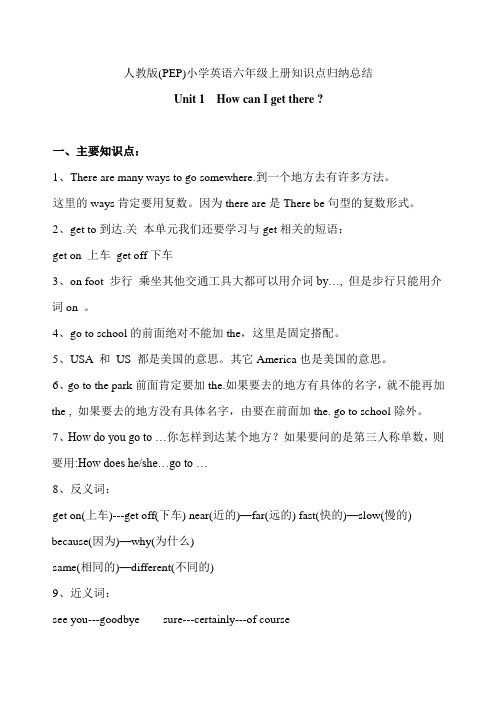
人教版(PEP)小学英语六年级上册知识点归纳总结Unit 1 How can I get there ?一、主要知识点:1、There are many ways to go somewhere.到一个地方去有许多方法。
这里的ways肯定要用复数。
因为there are是There be句型的复数形式。
2、get to到达.关本单元我们还要学习与get相关的短语:get on 上车get off下车3、on foot 步行乘坐其他交通工具大都可以用介词by…, 但是步行只能用介词on 。
4、go to school的前面绝对不能加the,这里是固定搭配。
5、USA 和US 都是美国的意思。
其它America也是美国的意思。
6、go to the park前面肯定要加the.如果要去的地方有具体的名字,就不能再加the , 如果要去的地方没有具体名字,由要在前面加the. go to school除外。
7、How do you go to …你怎样到达某个地方?如果要问的是第三人称单数,则要用:How does he/she…go to …8、反义词:get on(上车)---get off(下车) near(近的)—far(远的) fast(快的)—slow(慢的) because(因为)—why(为什么)same(相同的)—different(不同的)9、近义词:see you---goodbye sure---certainly---of course10、频度副词:always 总是,一直usually 通常often经常sometimes 有时候never 从来不二、主要单词:museum博物馆bookstore书店cinema电影院turn 转弯hospital医院left向左post office 邮局science科学right向右straight笔直地crossing 十字路口三、习惯语搭配:post office邮局science museum科学博物馆pet hospital宠物医院Italian restaurant意大利餐馆Beihai Park北海公园Palace Museum故宫博物院go straight直走turn right/left右/左转next to挨着in front of...在...前面near the park在公园附近on Dongfang Street在东方大街上四、惯用表达式:by plane 坐飞机by ship 坐轮船on foot步行by bike 骑自行车by bus 坐公共汽车by train 坐火车traffic lights交通灯traffic rules交通规则Stop at a red light 红灯停Wait at a yellow light 黄灯等Go at a green light 绿灯行Excuse me 打扰一下Follow me, please!请跟着我!五、主要句子:How do you go to school你怎么去上学?Usually I go to school on foot. Sometimes I go by bus.通常我步行去上学。
新版PEP小学英语六年级上册1-6单元知识点总结
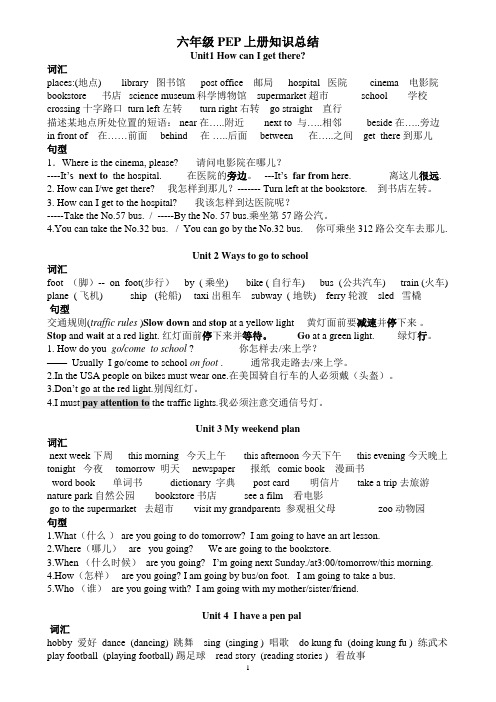
六年级PEP上册知识总结Unit1 How can I get there?词汇places:(地点) library 图书馆 post office 邮局 hospital 医院 cinema 电影院bookstore 书店 science museum科学博物馆 supermarket 超市 school 学校crossing 十字路口 turn left 左转 turn right 右转 go straight 直行描述某地点所处位置的短语: near 在…..附近 next to 与…..相邻 beside 在…..旁边in front of 在……前面 behind 在…..后面 between 在…..之间 get there 到那儿句型1.Where is the cinema, please? 请问电影院在哪儿?----It’s next to the hospital. 在医院的旁边。
---It’s far from here. 离这儿很远.2. How can I/we get there? 我怎样到那儿?------- Turn left at the bookstore. 到书店左转。
3. How can I get to the hospital? 我该怎样到达医院呢?-----Take the No.57 bus. / -----By the No. 57 bus.乘坐第57路公汽。
4.You can take the No.32 bus. / You can go by the No.32 bus. 你可乘坐312路公交车去那儿.Unit 2 Ways to go to school词汇foot (脚)-- on foot(步行) by ( 乘坐) bike ( 自行车) bus (公共汽车) train (火车) plane ( 飞机) ship (轮船) taxi 出租车 subway ( 地铁) ferry 轮渡 sled 雪橇句型交通规则(traffic rules )Slow down and stop at a yellow light 黄灯面前要减速并停下来。
小学英语PEP六年级上册4-6单元知识点总结
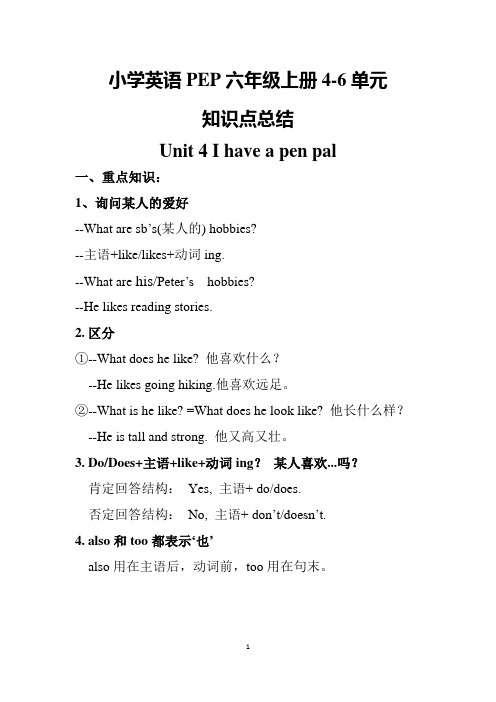
小学英语PEP六年级上册4-6单元知识点总结Unit 4 I have a pen pal一、重点知识:1、询问某人的爱好--What are sb’s(某人的) hobbies?--主语+like/likes+动词ing.--What are his/Peter’s hobbies?--He likes reading stories.2.区分①--What does he like? 他喜欢什么?--He likes going hiking.他喜欢远足。
②--What is he like? =What does he look like? 他长什么样?--He is tall and strong. 他又高又壮。
3.Do/Does+主语+like+动词ing?某人喜欢...吗?肯定回答结构:Yes, 主语+ do/does.否定回答结构:No, 主语+ don’t/doesn’t.4.also和too都表示‘也’also用在主语后,动词前,too用在句末。
5.宾语6.区别What is his hobby?(单数)What are his hobbies?(复数)7.be interested in对...感兴趣二、动词变三单:1、一般情况是在动词后加-s如:read - reads,write - writes,say – says2、以s,x,ch,sh,结尾的词加-es如:teach - teaches,wash - washes,3、①以辅音字母+y结尾的词变y为i再加-es如:try - tries②元音直接+s如:play -plays4、不规则变化如:have- has go-goes do-does三、动词ing变化规则:1、一般情况下,直接在动词后加-ing如:study ----- studying2、以不发音的e结尾,要去e加ing如:take - taking make -- making dance ---- dancing3、双写词尾字母,再加-ing如:run ----- runningswim----swimmingshop-shopping四、如何把肯定句变成一般疑问句1.如果有be动词和情态动词,直接把他们放在句首,I,we变成you2.句中没有be动词和情态动词,则根据主语借助do/does,后面的动词用原形(I,we变成you,主语是三单才用does 其他用do)补充:be动词包括am,is,are;情态动词:can,must,will,should五.如何变否定句1.句中有be动词或情态动词直接在其后加not2.句中无be动词或情态动词,根据主语用don’t或doesn’t 放在主语后,且后面的动词用原形。
新版PEP小学英语六年级上册1-6单元知识点总结
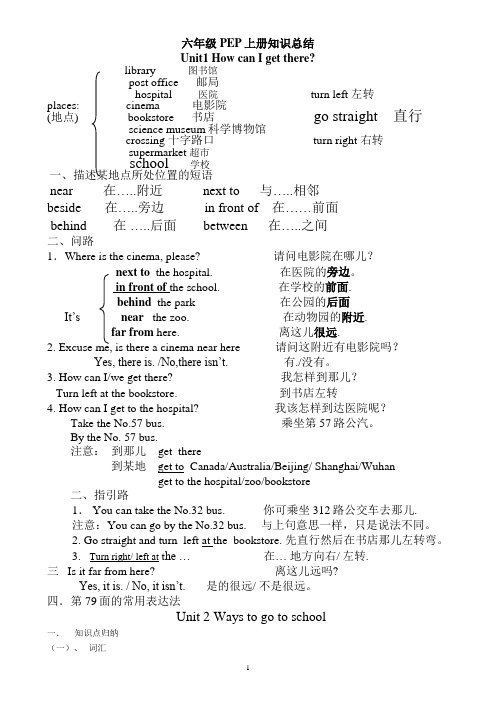
六年级PEP上册知识总结Unit1 How can I get there?library 图书馆post office 邮局hospital 医院turn left 左转places: cinema 电影院(地点) bookstore 书店go straight 直行science museum科学博物馆crossing 十字路口 turn right 右转supermarket 超市school 学校一、描述某地点所处位置的短语near 在…..附近 next to 与…..相邻beside 在…..旁边 in front of 在……前面behind 在…..后面 between 在…..之间二、问路1.Where is the cinema, please? 请问电影院在哪儿?next to the hospital. 在医院的旁边。
in front of the school. 在学校的前面.behind the park 在公园的后面It’s near the zoo. 在动物园的附近.far from here. 离这儿很远.2. Excuse me, is there a cinema near here 请问这附近有电影院吗?Yes, there is. /No,there isn’t. 有./没有。
3. How can I/we get there? 我怎样到那儿?Turn left at the bookstore. 到书店左转4. How can I get to the hospital? 我该怎样到达医院呢?Take the No.57 bus. 乘坐第57路公汽。
By the No. 57 bus.注意:到那儿 get there到某地 get to Canada/Australia/Beijing/ Shanghai/Wuhanget to the hospital/zoo/bookstore二、指引路1. You can take the No.32 bus. 你可乘坐312路公交车去那儿.注意:You can go by the No.32 bus. 与上句意思一样,只是说法不同。
(完整word版)pep六年级上册英语-各单元知识点总结
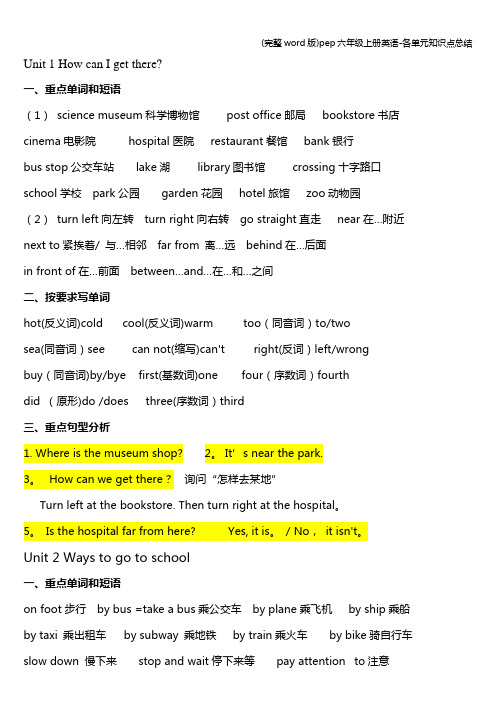
Unit 1 How can I get there?一、重点单词和短语(1)science museum科学博物馆post office邮局bookstore书店cinema电影院hospital医院restaurant餐馆bank银行bus stop公交车站lake湖library图书馆crossing十字路口school学校park公园garden花园hotel旅馆zoo动物园(2)turn left向左转turn right向右转go straight直走near在…附近next to紧挨着/ 与…相邻far from 离…远behind在…后面in front of在…前面between…and…在…和…之间二、按要求写单词hot(反义词)cold cool(反义词)warm too(同音词)to/twosea(同音词)see can not(缩写)can't right(反词)left/wrongbuy(同音词)by/bye first(基数词)one four(序数词)fourthdid (原形)do /does three(序数词)third三、重点句型分析1. Where is the museum shop? 2。
It’s near the park.3。
How can we get there?询问“怎样去某地”Turn left at the bookstore. Then turn right at the hospital。
5。
Is the hospital far from here? Yes, it is。
/ No,it isn't。
Unit 2 Ways to go to school一、重点单词和短语on foot步行by bus =take a bus乘公交车by plane乘飞机by ship乘船by taxi 乘出租车by subway 乘地铁by train乘火车by bike骑自行车slow down 慢下来stop and wait停下来等pay attention to注意cross the road横穿马路traffic light通信号灯at home在家look right向右看look at朝…看play with和…一起玩二、按要求写单词go (反义词)come foot(复数)feet child(复数)childrenearly(反义词)late good(反义词)bad take(反义词)bringslow(反义词)quick/fast go(过去式)went do(过去式)diddo(第三人称单数) does go(第三人称单数)goessame 相同的(反义词)different不同的miss(过去式)missedwrong 错误(反义词)right正确can(否定形式)can’t三、重点句型分析1。
六年级上pep知识点汇总

六年级上pep知识点汇总PEP(人教版英语教材)是中国小学生英语教育中常用的教材之一。
作为六年级上学期的学生,我们需要掌握并熟练运用各种知识点。
下面是对六年级上PEP教材知识点的汇总。
1. 单词与词组在六年级上学期的PEP教材中,我们学习了许多新单词和词组。
其中一些重要的单词和词组包括:- Greetings (问候语): Hello, Hi, Good morning, Good afternoon, Good evening- Numbers (数字): one, two, three, four, five, six, seven, eight, nine, ten- Colors (颜色): red, yellow, blue, green, orange, purple, white, black, brown- Days of the week (星期几): Monday, Tuesday, Wednesday, Thursday, Friday, Saturday, Sunday- Months of the year (月份): January, February, March, April, May, June, July, August, September, October, November, December- Classroom objects (教室物品): desk, chair, book, pencil, pen, ruler, eraser, backpack- Daily activities (日常活动): eat, sleep, study, play, read, write, listen, speak2. 语法知识除了单词和词组,我们在六年级上学期的PEP教材中还学习了一些基础的语法知识。
以下是一些重要的语法知识点:- 一般现在时:表示现在经常或习惯性发生的动作或状态。
PEP新版六年级上英语知识点归纳总结
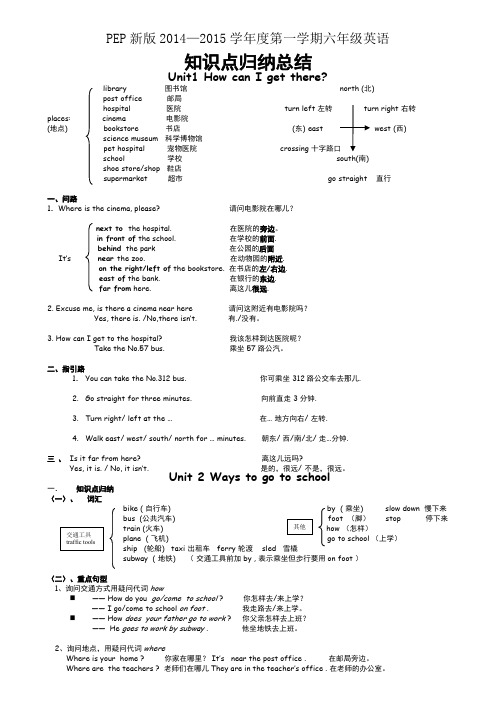
PEP 新版2014—2015学年度第一学期六年级英语知识点归纳总结Unit1 How can I get there?library 图书馆 north (北) post office 邮局 hospital 医院 turn left 左转右转places: cinema 电影院(地点) bookstore 书店 (东西) science museum 科学博物馆 pet hospital 宠物医院 crossing school 学校 south(南) shoe store/shop 鞋店 supermarket 超市 go straight 直行一、问路1.Where is the cinema, please? 请问电影院在哪儿? next to the hospital. 在医院的旁边。
in front of the school. 在学校的前面. behind the park 在公园的后面It’s near the zoo. 在动物园的附近.on the right/left of the bookstore. 在书店的左/右边.east of the bank. 在银行的东边.far from here. 离这儿很远.2. Excuse me, is there a cinema near here 请问这附近有电影院吗?Yes, there is. /No,there isn’t. 有./没有。
3. How can I get to the hospital? 我该怎样到达医院呢?Take the No.57 bus. 乘坐57路公汽。
二、指引路1. You can take the No.312 bus. 你可乘坐312路公交车去那儿.2. Go straight for three minutes. 向前直走3分钟.3. Turn right/ left at the … 在… 地方向右/ 左转.4. Walk east/ west/ south/ north for … minutes. 朝东/ 西/南/北/ 走…分钟.三 、 Is it far from here? 离这儿远吗?Yes, it is. / No, it isn’t. 是的,很远/ 不是,很远。
人教PEP版小学英语六年级上册Unit1-6单元知识小结-全册完整版
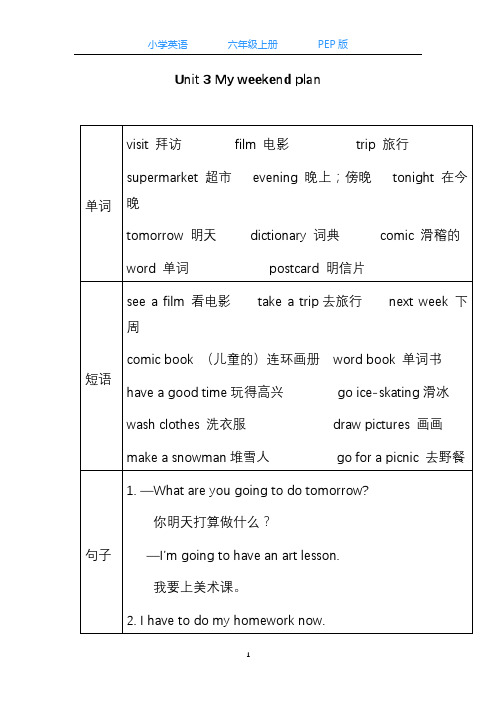
Unit 3 My weekend planUnit 4 I have a pen palUnit 5 What does he do?Unit 6 How do you feel?Unit 1 How can I get there?Unit 2 Ways to go to schoolPEP小学英语六年级上册重点单词和句型练习一、重点单词Unit 1:by ( ) foot( ) bike( ) bus( ) train( ) how( ) go to school() traffic()traffic light()traffic rule()stop()wait() get to()Unit 2library( ) post office( ) hospital( ) cinema( ) turn( ) bookstore( ) where( ) please( )next to( ) right ( ) left( ) straight( )then ( )Unit 3next week( ) this morning( ) this afternoon( )this evening ( ) comic book( ) post card( )newspaper( ) buy( )Unit 4hobby( ) ride a bike--riding a bike( ) dive--diving( )play the violin—playing the violin( ) make kites—making kites( ) collect stamps—collecting stamps( ) live –lives( ) teach--teaches( ) go--goes( ) watch--watches( ) read--reads( ) does doesn’t=does not Unit 5singer( ) writer( ) actor( ) actress( ) artist( ) TV reporter( ) engineer( ) accountant( ) policeman( ) salesperson( )cleaner( ) where() work()Unit 6rain( ) cloud ( ) sun( ) stream( ) come from( ) seed( ) soil( ) sprout ( ) plant( )should ( ) then( )Unit 1: ▁▁(经,乘) ▁▁(脚) ▁▁(自行车) ▁▁(公共汽车) ▁▁(火车)▁▁(怎样) ▁▁▁▁(上学)▁▁▁▁(交通)▁▁▁▁▁▁(交通灯)▁▁▁▁▁▁(交通规则)▁▁(停,停车站)▁▁(等待)▁▁▁▁(到达)Unit 2 ▁▁▁▁(图书馆) ▁▁▁▁(邮局) ▁▁▁▁(医院) ▁▁▁▁(电影院)▁▁(转弯) ▁▁▁▁(书店) ▁▁▁(在哪里,到哪里) ▁▁▁(请)▁▁▁(与…相邻) ▁▁▁ (右边) ▁▁(左边) ▁▁▁(成直线地) ▁▁▁(然后)Unit 3 ▁▁▁▁▁(下周) ▁▁▁▁▁(今天上午) ▁▁▁▁▁(今天下午) ▁▁▁▁ (今天晚上) ▁▁▁▁(漫画书) ▁▁▁▁(明信片) ▁▁▁▁ (报纸) ▁▁▁(购买)Unit 4▁▁▁(爱好) ▁▁▁▁▁--▁▁▁▁▁▁(骑自行车) ▁▁▁--▁▁▁(跳水) ▁▁▁▁▁▁—▁▁▁▁▁▁▁(拉小提琴) ▁▁▁▁▁—▁▁▁▁▁▁▁(制作风筝) ▁▁▁▁▁▁—▁▁▁▁▁▁(集邮) ▁▁▁–▁▁▁(居住)▁▁▁▁--▁▁▁▁(教) ▁▁--▁▁▁(去) ▁▁▁--▁▁▁(看)▁▁--▁▁▁(读,看) does doesn’t=▁▁▁▁Unit 5▁▁▁▁(歌唱家,歌手) ▁▁▁▁(作家) ▁▁▁▁(男演员) ▁▁▁▁(女演员) ▁▁▁▁(画家) ▁▁▁▁(电视台记者) ▁▁▁▁(工程师) ▁▁▁(会计) ▁▁▁▁(男警察) ▁▁▁▁▁▁(销售员) ▁▁▁(工作)▁▁▁▁(清洁工) ▁▁▁▁(在哪里,到哪里)Unit 6▁▁▁(雨) ▁▁▁ (云) ▁▁▁(太阳) ▁▁▁▁(河,溪) ▁▁▁▁(来自,从…来) ▁▁▁(种子) ▁▁▁(土壤) ▁▁▁ (苗,芽) ▁▁▁(植物,种植) ▁▁▁(应该) ▁▁▁▁(然后)二、单词分类1)交通方式:by bus, by train, by subway, by ship, by plane, by car, on foot2)文具书籍:dictionary, newspaper, comic book, post card3)职业:singer, writer, TV reporter, actor, actress, engineer, accountant, salesperson, policeman, policewoman,artist, cleaner4)V-ing形式:riding a bike, collecting stamps, diving, making kites, playing the violin5)第三人称单数形式:lives,teaches, watches, goes, does, doesn’t6)公共场所:library,post office, cinema, hospital, science museum, bookstore7)方位:east, west, south, north, turn left, turn right, go straight8)交通灯; red light, yellow light, green light9)自然:sun, cloud, rain, vapour, stream六年级上册四会句子1.你是怎样去上学的?▁▁▁▁▁▁▁▁2.通常我走路去上学。
pep小学六年级英语上册知识点

pep小学六年级英语上册知识点PEP小学六年级英语上册收纳了一系列基础的语法、词汇和句型知识点,帮助学生打下坚实的英语基础。
本文将介绍该教材上册中涉及的主要知识点,包括动词的时态、名词的单复数、形容词的比较级和最高级、时间表达等内容。
一、动词时态1. 一般现在时:表示经常性或习惯性的动作,如:I go to school every day.2. 现在进行时:表示正在进行的动作,如:She is playing basketball right now.3. 过去式:表示过去发生的动作,如:They visited the museum last week.4. 将来时:表示将要发生的动作,如:We will have a picnic next Saturday.二、名词的单复数1. 可数名词的单复数:一般在词尾加-s,如:apple - apples2. 以-s,-sh,-ch,-x结尾的名词:在词尾加-es,如:box - boxes3. 以辅音字母+y结尾的名词:将y改为i,再加-es,如:baby - babies4. 不规则名词:有些名词的单复数形式不规则,如:man - men, woman - women三、形容词的比较级和最高级1. 比较级的构成:在形容词后加-er,如:tall - taller2. 最高级的构成:在形容词前加the,并在词尾加-est,如:hot - the hottest3. 比较级和最高级的变化规则:有些形容词变化不规则,如:good - better - the best四、时间表达1. 星期几的表达:Monday, Tuesday, Wednesday, Thursday, Friday, Saturday, Sunday2. 日常活动的表达:比如:get up, have breakfast, go to school, have lunch, go home, do homework, go to bed等。
人教版(PEP)小学英语六年级上册各单元知识点归纳(三年级起点)
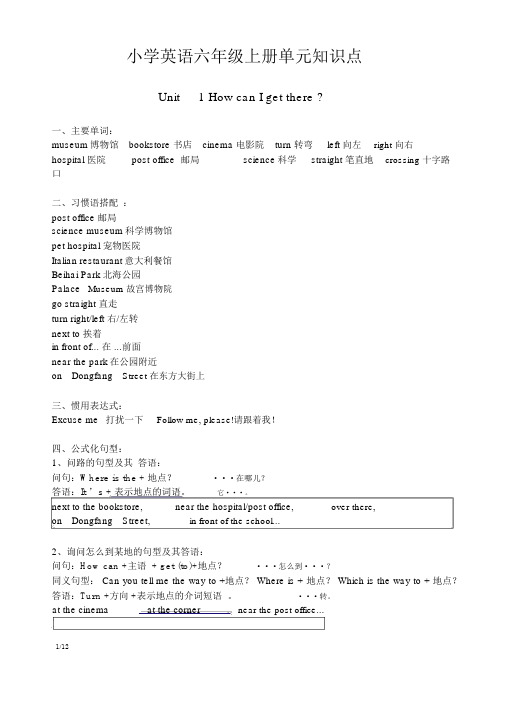
小学英语六年级上册单元知识点Unit 1 How can I get there ?一、主要单词:museum博物馆bookstore 书店cinema 电影院turn 转弯left 向左right 向右hospital 医院post office 邮局science科学straight 笔直地crossing 十字路口二、习惯语搭配:post office 邮局science museum科学博物馆pet hospital 宠物医院Italian restaurant意大利餐馆Beihai Park 北海公园Palace Museum 故宫博物院go straight 直走turn right/left 右/左转next to 挨着in front of... 在 ...前面near the park在公园附近on Dongfang Street 在东方大街上三、惯用表达式:Excuse me打扰一下Follow me, please!请跟着我!四、公式化句型:1、问路的句型及其答语:问句:Where is the + 地点?···在哪儿?答语:It ’s + 表示地点的词语。
它···。
next to the bookstore,near the hospital/post office,over there,on Dongfang Street,in front of the school...2、询问怎么到某地的句型及其答语:问句:How can +主语 + get (to)+地点?···怎么到···?同义句型: Can you tell me the way to +地点? Where is + 地点? Which is the way to + 地点?答语:Turn +方向 +表示地点的介词短语。
新版pep六年级上册英语-各单元知识点总结
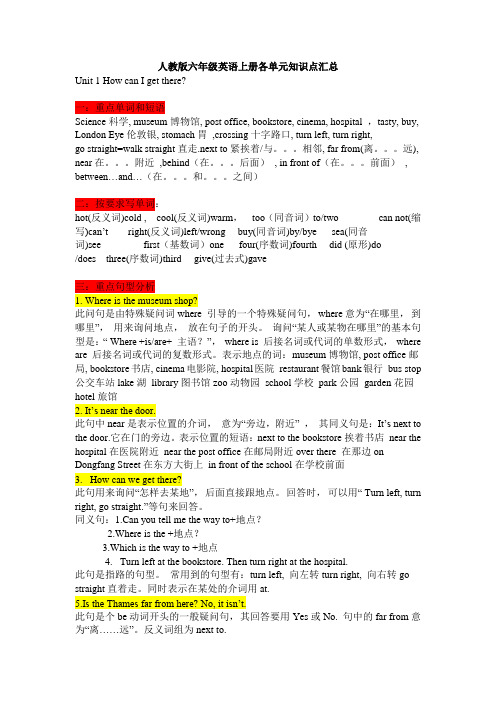
人教版六年级英语上册各单元知识点汇总Unit 1 How can I get there?一:重点单词和短语Science科学, museum博物馆, post office, bookstore, cinema, hospital ,tasty, buy, London Eye伦敦银, stomach胃,crossing十字路口, turn left, turn right,go straight=walk straight直走.next to紧挨着/与。
相邻, far from(离。
远), near在。
附近,behind(在。
后面), in front of(在。
前面), between…and…(在。
和。
之间)二:按要求写单词:hot(反义词)cold , cool(反义词)warm,too(同音词)to/two can not(缩写)can’t right(反义词)left/wrong buy(同音词)by/bye sea(同音词)see first(基数词)one four(序数词)fourth did (原形)do/does three(序数词)third give(过去式)gave三:重点句型分析1. Where is the museum shop?此问句是由特殊疑问词where 引导的一个特殊疑问句,where意为“在哪里,到哪里”,用来询问地点,放在句子的开头。
询问“某人或某物在哪里”的基本句型是:“ Where +is/are+ 主语?”,where is 后接名词或代词的单数形式,where are 后接名词或代词的复数形式。
表示地点的词:museum博物馆, post office邮局, bookstore书店, cinema电影院, hospital医院restaurant餐馆bank银行bus stop 公交车站lake湖library图书馆zoo动物园school学校park公园garden花园hotel旅馆2. It’s near the door.此句中near是表示位置的介词,意为“旁边,附近” ,其同义句是:It’s next to the door.它在门的旁边。
pep英语六年级上册知识点

pep英语六年级上册知识点PEP英语六年级上册是小学六年级上学期的英语教材,涵盖了各种语法、词汇和语言技巧。
本文将为大家详细介绍PEP英语六年级上册的知识点,帮助同学们更好地学习和掌握英语。
一、基础词汇1. 单词PEP英语六年级上册教材中包含大量的单词,如动物、食物、交通工具等。
同学们需要掌握这些单词的拼写、发音和意思。
2. 日常用语在英语学习中,掌握一些常用的日常用语非常重要。
PEP英语六年级上册教材中提供了一些常见的日常用语,如问候、道别、请求等,同学们要学会运用这些用语进行简单的对话。
二、语法知识1. 一般现在时PEP英语六年级上册介绍了一般现在时的用法,包括肯定句、否定句和疑问句的构成。
同学们要学会运用一般现在时来描述自己的日常活动。
2. 数词PEP英语六年级上册还包含了1至100的数词,并介绍了基数词和序数词的用法。
同学们需要学会读写这些数词,并能够在实际应用中正确使用它们。
3. 形容词比较级在PEP英语六年级上册中,同学们将学习形容词的比较级,了解不同事物之间的大小或程度关系。
同学们需要学会构成形容词的比较级,并在实际交流中正确使用。
4. 介词PEP英语六年级上册教材中还介绍了一些常见的介词,如in、on、under等。
同学们需要理解介词的用法,能够准确地描述物体的位置和方位关系。
三、阅读技巧1. 阅读理解PEP英语六年级上册中包含了一些简短的阅读材料,同学们需要通过阅读理解材料中的问题,提高自己的阅读理解能力,包括理解文章大意、获取关键信息和推断文中隐含的意思。
2. 识别关键词当进行阅读时,同学们需要学会识别关键词,通过关键词快速理解和归纳文章内容。
PEP英语六年级上册教材中的阅读材料将帮助同学们培养识别关键词的能力。
四、口语训练1. 听力训练PEP英语六年级上册教材中包含了一些听力材料,同学们需要通过听力训练来提高自己的听力理解能力。
可以多听英语歌曲、故事,进行模仿和跟读。
2. 口语表达PEP英语六年级上册教材提供了一些对话和口语训练,同学们需要通过模仿、朗读和角色扮演的形式,提高自己的口语表达能力。
pep六年级上册1至3单元知识点
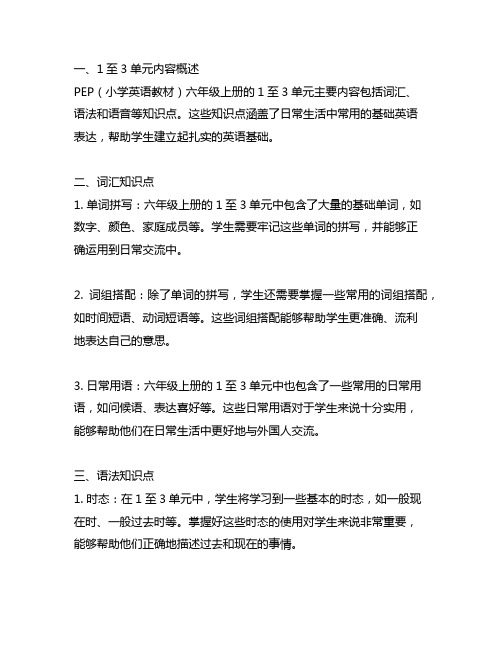
一、1至3单元内容概述PEP(小学英语教材)六年级上册的1至3单元主要内容包括词汇、语法和语音等知识点。
这些知识点涵盖了日常生活中常用的基础英语表达,帮助学生建立起扎实的英语基础。
二、词汇知识点1. 单词拼写:六年级上册的1至3单元中包含了大量的基础单词,如数字、颜色、家庭成员等。
学生需要牢记这些单词的拼写,并能够正确运用到日常交流中。
2. 词组搭配:除了单词的拼写,学生还需要掌握一些常用的词组搭配,如时间短语、动词短语等。
这些词组搭配能够帮助学生更准确、流利地表达自己的意思。
3. 日常用语:六年级上册的1至3单元中也包含了一些常用的日常用语,如问候语、表达喜好等。
这些日常用语对于学生来说十分实用,能够帮助他们在日常生活中更好地与外国人交流。
三、语法知识点1. 时态:在1至3单元中,学生将学习到一些基本的时态,如一般现在时、一般过去时等。
掌握好这些时态的使用对学生来说非常重要,能够帮助他们正确地描述过去和现在的事情。
2. 语法结构:学生还需要掌握一些基本的语法结构,如肯定句、否定句、疑问句等。
这些基本的语法结构是构建语言表达能力的基石,对学生的语言能力提升有着重要的作用。
四、语音知识点1. 发音准确性:在1至3单元中,学生将学习一些基础的英语发音规则,包括元音、辅音的发音技巧等。
通过反复练习,帮助学生提高发音的准确性,使他们能够更加清晰地表达自己的意思。
2. 语音连读:学生还需要学习一些基本的语音连读规则,如连读音、重读音等。
这些规则能够帮助学生更好地理解和模仿地道的英语发音,提高他们的口语表达能力。
五、总结PEP六年级上册的1至3单元涵盖了大量的英语基础知识,包括词汇、语法和语音等方面。
通过系统的学习和练习,学生能够建立起扎实的英语基础,为今后的英语学习打下坚实的基础。
这些知识点也是学生未来学习更复杂英语知识的基础,对于学生的英语学习之路具有重要的意义。
在前面的内容中,我们已经对PEP六年级上册1至3单元的知识点进行了概述,包括词汇、语法和语音等方面。
新版PEP小学英语六年级上册1-6单元知识点总结

一、问路1. Where is the cinema, please next to the hospital. in front of the school.beh ind the park n ear the zoo. on the right/left of the bookstore.在书店的左/ 右边. east of the bank. 在银行的 东边. i far from here.离这儿 很远.请问这附近有电影院吗 有./没有。
我该怎样到达医院呢 You can take the bus. Go straight for three minu tes. Turn right/ left at the Walk east/ west/ south/ n orth for 三 Is it far from here离这儿远吗Yes, it is. / No, it isn 是的很远t 不是很远。
Unit 2 Ways to go to schoolsubway 地(^)(交通工具前加by ,表示乘坐但步行要用on foot )(二)、重点句型 ①询问交通方式用疑问代词howplaces: (地点)六年级PEP 上册知识总结 Un itl How can I get therelibrary 图书馆 post office 邮局 hospital 医院 ci nema 电影院 bookstore 书店 scie nee mu 科学博物馆 pet hospital 宠物医院 school 学校 supermarket 超市 shoe store 鞋店 north 北) turn left 左转 turn right 右转 东)east cross in 十 souths^wes 西()字路口go straigh 直 行请问电影院在哪儿在医院的旁边。
在学校的前面. 在公园的后面 在动物园的附近.It ' s J 2. Excuse me, is there a cin ema n earhereY es, there is. /No,there isnt.3. How can I get to the hospitalTake the …..…二、指引路 1. 2. 3. 4. 你可乘坐312路公交车去那儿. 向前直走在分钟. …在…地方向右/左转. 朝东•/ nSn 南e 北匕/走…分钟. 知识点归纳J 、 词汇 四会交通工具 traffic tools<bike (自行车)bu 公共汽车)tra 火车) pla ne 飞叽) shi 轮船)taxi 出租车b 乘坐)slow down 慢下来foo (脚)stop 停下来 how 怎样) go to schoo 止 学) sled 雪橇ferry 轮渡—— How do you go/come to school你怎样去/来上学----- I go/come to school on foot . 我走路去/ 来上学。
六年级pep上册知识点总结
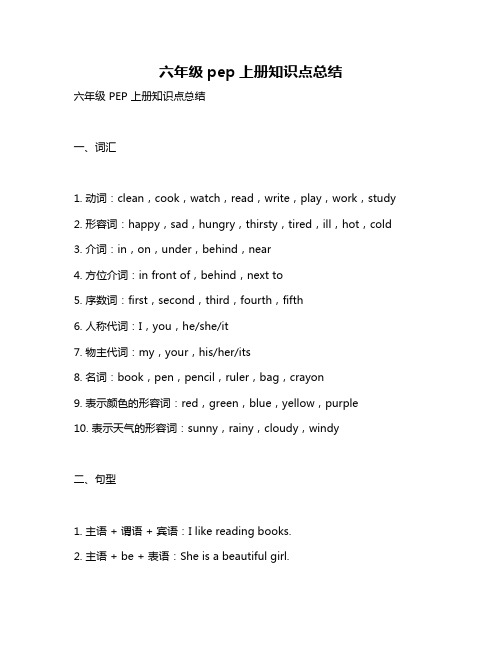
六年级pep上册知识点总结六年级 PEP 上册知识点总结一、词汇1. 动词:clean,cook,watch,read,write,play,work,study2. 形容词:happy,sad,hungry,thirsty,tired,ill,hot,cold3. 介词:in,on,under,behind,near4. 方位介词:in front of,behind,next to5. 序数词:first,second,third,fourth,fifth6. 人称代词:I,you,he/she/it7. 物主代词:my,your,his/her/its8. 名词:book,pen,pencil,ruler,bag,crayon9. 表示颜色的形容词:red,green,blue,yellow,purple10. 表示天气的形容词:sunny,rainy,cloudy,windy二、句型1. 主语 + 谓语 + 宾语:I like reading books.2. 主语 + be + 表语:She is a beautiful girl.3. 主语 + have/has + 宾语:I have a new pen.4. 主语 + will + 动词原形:I will go to the park tomorrow.5. 特殊疑问词 + 一般疑问句:What is your name?6. 方位介词短语作地点状语:I live in Beijing.7. 表示时间顺序的副词:First, I clean the room. Then, I cook dinner.8. 表示因果关系的连词:Because I'm ill, I can't go to school today.9. 表示条件关系的连词:If you study hard, you will pass the exam.10. 表示转折关系的连词:Although it's raining, we still want to go out and play.。
- 1、下载文档前请自行甄别文档内容的完整性,平台不提供额外的编辑、内容补充、找答案等附加服务。
- 2、"仅部分预览"的文档,不可在线预览部分如存在完整性等问题,可反馈申请退款(可完整预览的文档不适用该条件!)。
- 3、如文档侵犯您的权益,请联系客服反馈,我们会尽快为您处理(人工客服工作时间:9:00-18:30)。
(完整word版)PEP小学英语六年级上册知识点总结-整理版编辑整理:尊敬的读者朋友们:这里是精品文档编辑中心,本文档内容是由我和我的同事精心编辑整理后发布的,发布之前我们对文中内容进行仔细校对,但是难免会有疏漏的地方,但是任然希望((完整word版)PEP小学英语六年级上册知识点总结-整理版)的内容能够给您的工作和学习带来便利。
同时也真诚的希望收到您的建议和反馈,这将是我们进步的源泉,前进的动力。
本文可编辑可修改,如果觉得对您有帮助请收藏以便随时查阅,最后祝您生活愉快业绩进步,以下为(完整word版)PEP小学英语六年级上册知识点总结-整理版的全部内容。
Unit 1 How Do You Go There ?一. 知识点归纳(一)、 词汇四会 bike ( 自行车) by ( 乘坐) bus (公共汽车) foot (脚)train (火车) how (怎样) plane ( 飞机) go to school (上学)ship (轮船) subway ( 地铁) ( 交通工具前加by , 表示乘坐但步行要用on foot )fifth 第五 remember 记住 find 找到difference 不同 same 相同的 every 每个 所有的三会 country 国家 mean 意思是 drive 驾驶right 右边的 side 边 England 英国Australia 澳大利亚 however 但是left 左边的if 如果 must 必须(二)、重点句型主要句子:How do you go to school ?你怎么去上学?Usually I go to school on foot. Sometimes I go by bus.通常我步行去上学.有时候骑自行车去。
How can I get to Zhongshan Park ?我怎么到达中山公园?You can go by the No 。
15 bus 。
你可以坐15路公共汽车去.Stop at a red light 。
红灯停Wait at a yellow light 。
黄灯停Go at a green light 。
绿灯行In China and the US , drivers drive on the right side of the road 。
在中国和美国,司机靠右行驶。
In England and Australia, however, drivers drive on the left side ofthe road 。
其他 交通工具traffic但是在英国和澳大利亚,司机靠左边行驶。
Unit 2 Where is the science museum?词 汇library 图书馆 north (北) post office 邮局 hospital 医院 places: cinema 电影院 (地点) bookstore 书店 (东) east west (西) science musem 科学博物馆 bank 银行 school 学校 south (南) supermarket 超市 shoe store 鞋店四会单词: where 在哪里 please 请 next to 与…相邻right 右边,正确的 left 左边 straight 成直线地 then 然后 turn 转弯认读单词:excuse me 对不起 want 想要 a pair of 双 minute 分钟 tell 告诉 take 乘坐 far 远 after school 放学以后 get off 下车get on 上车 twelfth 第十二 party 聚会;晚会 start 开始 buy 买句 型一、问路1.Where is the cinema, please? 请问电影院在哪儿?next to the hospital 。
在医院的旁边.in front of the school 。
在学校的前面。
behind the park 在公园的后面near the zoo 。
在动物园的附近。
on the right/left of the bookstore. 在书店的左/右边。
east of the bank 。
在银行的东边.far from here 。
离这儿很远。
2. Excuse me, is there a cinema near here ? 请问这附近有电影院吗?Yes , there is 。
有.3。
How can I get to the hospital ? 我该怎样到达医院呢?You can go …二、指引路四会单词 It ’1.You can go by the No.312 bus。
你可乘坐312路公交车去那儿。
2。
Get on / off at the … 在…地方上车/ 下车.3。
Walk straight for three minutes。
向前直走在分钟。
4. Turn right/ left at the … 在… 地方向右/ 左转。
5. Walk east/ west/ south/ north fo r … minutes.朝东/ 西/南/北/ 走…分钟.三 Is it far from here?离这儿远吗?Yes, it is. / No, it isn’t.Unit 3 What are you going to do?一.知识点归纳(一)、词汇四会next week 下周newspaper 报纸t his morning 今天上午comic book漫画书Time this afternoon 今天下午magazine杂志(时间 ) this evening 今天晚上dictionary 字典tonight 今夜post card 明信片tomorrow 明天take a trip去旅游theme park 主题公园activities buy some fruit买一些水果otherspet shop宠物店(活动)go to the cinema 去看电影(其他) fruit stand 水果摊visit the Great Wall 参观长城shoe store鞋店read a magazine about plants阅读有关植物的杂志shop商店三会:busy忙碌的together一起地 need需要else其他二、重点句式和句型:三、重点句型:本单元中出现的一个重点语法项目是一般将来时:表示将要发生的动作或状态 ,常和表示将来的时间连用.1——-——What are you going to do on the weekend?—-———I’m going to visit my grandparents this weekend?2。
—--——Where are you going this afternoon?———--——I’m going to the bookstore。
3。
-—-—- What are you going to buy?你打算去买什么?--——--I’m going to buy a comic book。
我打算去买一本漫画书.4.---—-When are you going to the bookstore?This afternoon。
4。
How are you going to the bookstore?I'm not going to the bookstore by bus5. I’m going to have a busy weekend!我将要度过一个繁忙的周末。
6。
That will be fun! 那将会很有意思。
7. What else?还要什么?8。
—---What are you going to do in the future? 你将来想干什么?—-—-—I'm going to be a science teacher one day. 我想将来有一天当科学老师.——-—- What about you ? 你呢?———--I want to be a computer expert in the future。
我想当个电脑专家。
Unit 4 I have a pen pal知识点归纳:一. 本单元主要是谈论某人的兴趣爱好。
二. 语法是动词的—ing 形式和动词的第三人称单数形式。
三. 词汇: ride a bike (rid ing a bike) 骑自行车dive (div ing ) 跳水hobby play the violin (play ing the volin ) 拉小提琴(爱好) make kites (mak ing kites ) 制作风筝collect stamps (collect ing stamps ) 集邮live (live s ) 居住,住 teach (teach es ) 教 go (go es ) 去 watch (watch es ) 看read (read s ) 读 do (do es )其他:show (展览) pen pal (笔友) dear (亲爱的) twin(双胞胎之一) look (看上去) fun (快乐,乐趣) with (同…)四.句型:四会句型:—What's your hobby? 你的爱好是什么?--I like collecting stamps. 我喜欢集邮.He likes collecting stamps , too 。
他也喜欢集邮。
—Does she teach English ? 她是教英语的吗?--No, she doesn’t。
/Yes, she does. 不,她不是。
/是,她是的.知识点:1. 询问某人的爱好:—---What’s your hobby? 你的爱好是什么?--——I like collecting stamps. 我喜欢集邮2. 表示征求别人意见:(1)-—-—what about you ? 你呢?-—-—Me too. 我也是。
(2)—-— Let’s go together。
让我们一起去吧.(3)--—— Can he go with us ?----— Sure !请记住:1。
当询问一个人的爱好时,like (喜欢)后面动词要加—ing 形式。
例如:--What's your hobby? ——I like swimming 。
/He likes riding a bike 。
